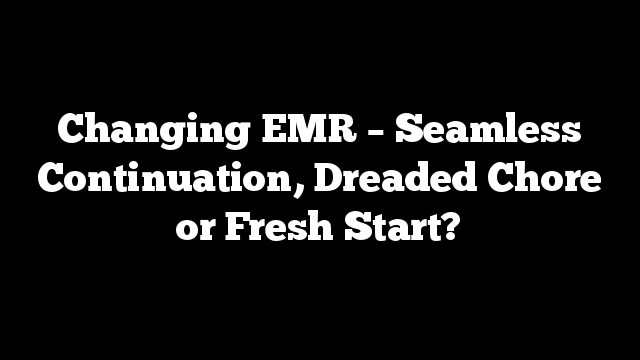
By HANS DUVEFELT, MD
At the end of the year my patients and I will start over. That is what changing EMRs does to us. I have mixed feelings about data migration, if it even happens.
I will move into a new virtual environment and my patients will take on slightly different appearances, maybe even alter their medical histories. Some will perhaps be asking me to edit diagnoses that have haunted them since we went from paper to computer records almost a decade ago.
With our first EMR, we scanned in a few things from patients’ paper records – sometimes only a few pages from years or decades of first handwritten and later typed notes. Much got lost, because we were doing something we never really had thought through, and we had to do it with a clock ticking: “Hurry, before the Federal incentives go away”. The Feds wanted EMRs because the vision was that more data would help research and population health and also reduce medical errors.
This time, another factor is pushing us forward: The EMR we have will no longer be supported after a certain date, and for an EMR that requires continuous tinkering in order to do basic tasks consistently, that is an untenable scenario. Only yesterday, I was suddenly unable to send prescriptions electronically and it took the national headquarter’s involvement to get me up and running again.
Our old EMR will become “read-only”, and who knows how much structured data will “migrate” from the old to the new system. And some information that should have been structured isn’t, because the old system’s search function was clunky enough that if we couldn’t find the exact word for a rare diagnosis in someone’s medical history, we would give up and choose the generic “neurologic disorder” and then free text the thing we might not even be spelling correctly. That still displayed intelligibly enough while the system was live, but will that migrate to the new system – who knows? Of course, there will be opportunities to correct old mistakes and omissions, as long as there is time…
The only way to view this inevitable transition is as an opportunity to undo old beginner mistakes, bad habits and workarounds. Having worked with two systems in my two clinics, I feel this is a bit like learning a new language or instrument; I know better what functionality I am looking for and will recognize it when I see it – just like a Spanish word I don’t know might look similar to a French word I do know for the same thing.
Wise from my positive experiences of screen sharing, I will bring patients along on this journey. I will be sitting next to each one with my laptop in front of us. I will invite them to update their history and increase the transparency of how I work, because there isn’t enough time in the day to keep the EMR invisible from my patient and then do all that work outside the appointment. Also, this is an era of increasing patient centeredness and I want to embrace that as much as I can.
I am determined to become as expert as possible with the new system so that I can document everything in real time in the visit and use more of my non-patient time in front of the screen to build templates and things like that.
In a way I feel a bit like many, many years ago when, as a student or budding writer, I opened a brand new notebook and put my pen to it for the first time. I loved fountain pens, crisp paper, leather bindings and the potential of all that clean, empty space.
Instead of feeling this EMR change will be a chore, I feel like a new school year or a new writing project is just about to begin.
Hans Duvefelt is a Swedish-born rural Family Physician in Maine. This post originally appeared on his blog, A Country Doctor Writes, here.
The post Changing EMR – Seamless Continuation, Dreaded Chore or Fresh Start? appeared first on The Health Care Blog.
